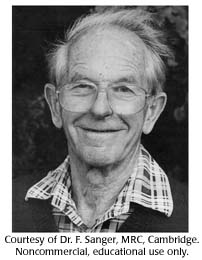டிஎன்ஏ நியூக்ளியோடைட்களின் வரிசையே மரபணுவாகும். A gene is a discrete sequence of DNA nucleotides.
 Frederick Sanger received two Nobel prizes (in the same category), for his work on protein sequencing and DNA sequencing.
Frederick Sanger received two Nobel prizes (in the same category), for his work on protein sequencing and DNA sequencing.
Frederick Sanger (1918-)

Frederick Sanger was born in Rendcombe, England. His father was a medical doctor and it was expected that Fred would also enter the medical field. As Sanger grew up, he became very interested in nature and science and when he went to Cambridge University, he made the decision not to study medicine. He felt that a career in science would give him a better chance to become a problem solver.
Sanger was a conscientious objector during the war because of his Quaker upbringing. After his B.A. in 1939, he stayed at Cambridge to do a Ph.D. with Albert Neuberger, on amino acid metabolism. After his Ph.D. in 1943, Sanger started working for A. C. Chibnall, on identifying the free amino groups in insulin. In the course of identifying the amino groups, Sanger figured out ways to order the amino acids. He was the first person to obtain a protein sequence. By doing so, Sanger proved that proteins were ordered molecules and by analogy, the genes and DNA that make these proteins should have an order or sequence as well. Sanger won his first Nobel Prize for Chemistry in 1958 for his work on the structure of protein.
By 1951, Sanger was on the staff of the Medical Research Council at Cambridge University. In 1962, he moved with the Medical Research Council to the Laboratory of Molecular Biology in Cambridge where Francis Crick, John Kendrew, Aaron Klug and others were all working on a DNA-related problem. Solving the problem of DNA sequencing became a natural extension of his work in protein sequencing. Sanger initially investigated ways to sequence RNA because it was smaller. Eventually, this led to techniques that were applicable to DNA and finally to the dideoxy method most commonly used in sequencing reactions today. Sanger won a second Nobel Prize for Chemistry in 1980 sharing it with Walter Gilbert, for their contributions concerning the determination of base sequences in nucleic acids, and Paul Berg for his work on recombinant DNA.
Sanger retired in 1985 and spends most of his time working in his garden. He gives his wife, Margaret Joan, a lot of credit for being a supportive helpmate in the non-science part of his life. In 1992, the Wellcome Trust and the Medical Research Council established the Sanger Centre, a research center for furthering the knowledge of genomes. The Sanger Centre was one of the main sequencing centers of the Human Genome Sequencing Project and sequencing projects of other organisms are also underway at the Sanger Centre. By all accounts, Sanger is a true "gentle" man, extremely courteous and charming.


Fred Sanger is among the select few who have won two or more Nobel prizes in the same category. John Bardeen won twice in Physics, and the International Committee of the Red Cross won three times in the Peace category.

Regions that are high in GC nucleotide content are technically more difficult to sequence through then regions high in AT content. Why do you think this is true?
 உட்கருவின் முக்கிய மூலக்கூறுகள் டிஎன்ஏ மற்றும் புரதங்களாகும்.
உட்கருவின் முக்கிய மூலக்கூறுகள் டிஎன்ஏ மற்றும் புரதங்களாகும். ஒரு மரபணு ஒரு புரதத்தை உருவாக்குகிறது.
ஒரு மரபணு ஒரு புரதத்தை உருவாக்குகிறது. ஒரு மரபணு டிஎன்ஏ' வால் ஆனது.
ஒரு மரபணு டிஎன்ஏ' வால் ஆனது. பாக்டீரியா மற்றும் வைரஸ்களிலும் டிஎன்ஏ'கள் உள்ளன.
பாக்டீரியா மற்றும் வைரஸ்களிலும் டிஎன்ஏ'கள் உள்ளன. டிஎன்ஏ-மூலக்கூறு, முறுக்கப்பட்ட ஏணி போன்று வடிவமைக்கப்பட்டுள்ளது.
டிஎன்ஏ-மூலக்கூறு, முறுக்கப்பட்ட ஏணி போன்று வடிவமைக்கப்பட்டுள்ளது. டிஎன்ஏ ஏணியின் ஒரு பாதி மற்றொன்றுக்கு வார்ப்புருவாகும்.
டிஎன்ஏ ஏணியின் ஒரு பாதி மற்றொன்றுக்கு வார்ப்புருவாகும்.  ஆர்என்ஏ'வானது, டிஎன்ஏ' மற்றும் புரதத்திற்கு இடையே ஓர் பாலமாக உள்ளது.
ஆர்என்ஏ'வானது, டிஎன்ஏ' மற்றும் புரதத்திற்கு இடையே ஓர் பாலமாக உள்ளது. டிஎன்ஏ'யின் வார்த்தைகள் மூன்று எழுத்துகளால் ஆனவையாகும்.
டிஎன்ஏ'யின் வார்த்தைகள் மூன்று எழுத்துகளால் ஆனவையாகும். டிஎன்ஏ நியூக்ளியோடைட்களின் வரிசையே மரபணுவாகும்.
டிஎன்ஏ நியூக்ளியோடைட்களின் வரிசையே மரபணுவாகும். ஆர்என்ஏ தகவல்கள் சில நேரங்களில் திருத்தியமைக்கப்படுகின்றன.
ஆர்என்ஏ தகவல்கள் சில நேரங்களில் திருத்தியமைக்கப்படுகின்றன. சில வைரஸ்கள் மரபணு தகவல்களை ஆர்என்ஏ'வில் சேமிக்கும்.
சில வைரஸ்கள் மரபணு தகவல்களை ஆர்என்ஏ'வில் சேமிக்கும். ஆர்என்ஏ'களே முதலிலெழுந்த மரபணு மூலக்கூறுகளாகும்.
ஆர்என்ஏ'களே முதலிலெழுந்த மரபணு மூலக்கூறுகளாகும்.  பிறழ்வுகளானவை, மரபணு தகவல்களின் மாற்றங்களாகும்.
பிறழ்வுகளானவை, மரபணு தகவல்களின் மாற்றங்களாகும்.  சில வகையான பிறழ்வுகள் தானாகவே சீர்திருத்தப்படும்.
சில வகையான பிறழ்வுகள் தானாகவே சீர்திருத்தப்படும்.